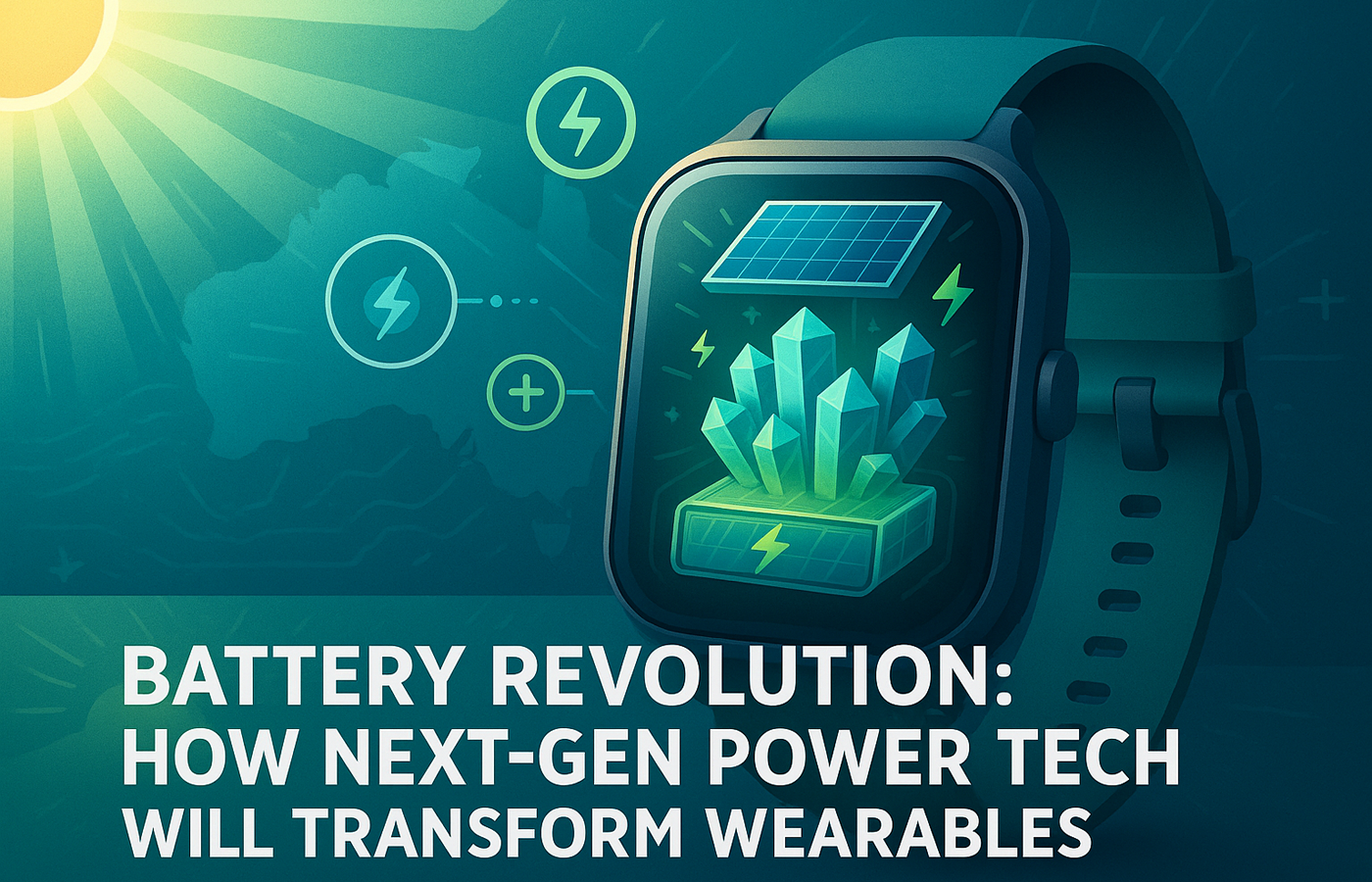Battery Revolution: How Next-Gen Power Tech Will Transform Wearables
For years, battery life has remained the Achilles’ heel of wearable technology—the single limitation that forces us to choose between advanced features and all-day reliability. However, a convergence of breakthrough technologies is poised to revolutionise how our wearable devices draw and store power, potentially eliminating the daily charging ritual and unlocking applications previously deemed impossible.
From solid-state batteries that could triple energy density to sophisticated solar charging systems that harness Australia’s abundant sunshine, these emerging technologies promise to transform wearables from battery-constrained devices into truly autonomous companions. For Australian users, these advances carry particular significance, addressing unique challenges posed by our extreme weather conditions, vast distances, and outdoor lifestyle.
The implications extend far beyond convenience. When wearables are no longer limited by battery constraints, entirely new categories of health monitoring, safety systems, and productivity tools become feasible, fundamentally changing how these devices integrate into our daily lives.
The Solid-State Battery Revolution
Understanding the Technology
Solid-state batteries represent perhaps the most promising advancement in wearable power technology. Unlike conventional lithium-ion batteries that use liquid electrolytes, solid-state designs employ solid materials—typically ceramics, glass, or specialised polymers—to conduct ions between electrodes.
TDK Corporation has successfully developed a material for solid-state batteries with 100-times higher energy density than their conventional mass-produced batteries. This breakthrough specifically targets wearable devices such as wireless earphones, hearing aids, and smartwatches, with the goal of replacing existing coin cell batteries.
The global solid-state battery market is projected to grow from $119.00 million in 2025 to $1,359.18 million by 2032, exhibiting a remarkable CAGR of 41.61%. This explosive growth reflects the technology’s potential to address fundamental limitations in current battery designs.
Advantages for Australian Users
Solid-state batteries offer several crucial advantages particularly relevant to Australian conditions:
Enhanced Safety: The solid electrolyte eliminates fire risks associated with traditional lithium-ion batteries—a significant benefit for devices used in Australia’s hot, dry conditions where thermal runaway poses increased risks.
Extreme Temperature Performance: Solid-state designs maintain performance across wider temperature ranges, crucial for Australia’s diverse climate zones from tropical Darwin to alpine regions where conventional batteries struggle.
Improved Energy Density: These batteries can achieve up to 400 Wh/kg energy density, potentially allowing wearables to run for weeks rather than days on a single charge.
Timeline and Commercial Availability
Mass production timelines vary among manufacturers. Samsung has earmarked the Galaxy Watch as the potential debut platform for solid-state batteries, with expectations pointing toward implementation around 2026. Meanwhile, Murata Manufacturing began mass production targeting earphone manufacturers and other wearables in 2021, though with limited capacity suitable for smaller devices.
Toyota and other automotive manufacturers are targeting 2025-2027 for broader solid-state implementation, suggesting the technology will mature rapidly over the next few years.
Solar Charging: Harnessing Australia’s Natural Advantage
Advanced Solar Integration
Australia’s abundant sunshine creates natural advantages for solar-powered wearables, yet current implementations barely scratch the surface of potential capabilities. Recent advances in flexible photovoltaic technology are making sophisticated solar integration increasingly viable for wearable devices.
Modern solar-powered wearables can generate up to 94 mW in outdoor conditions, effectively reducing battery size requirements while maintaining device functionality. This power output can offset 42% of typical device consumption even in suboptimal positioning, proportionally extending operating time between charges.
Innovative Materials and Design
Researchers are developing flexible solar cells that can be seamlessly integrated into wearable surfaces without compromising comfort or aesthetics. Carbon nanotube-based solar cells have achieved power conversion efficiency (PCE) of 11.94% while maintaining flexibility necessary for wearable integration.
Additionally, solar textiles are emerging that can be woven directly into clothing and accessories, creating energy-harvesting apparel that charges wearable devices throughout the day. These textiles maintain aesthetic appeal while providing renewable energy generation.
Australian Environmental Advantages
Australia’s high solar irradiance levels—among the world’s highest—provide optimal conditions for solar-powered wearables. Even accounting for panel curvature around wrists or arms, Australian conditions can provide sufficient energy to significantly extend battery life or eliminate charging requirements entirely.
Garmin’s Instinct 3 Series exemplifies current solar integration, featuring solar-powered displays that extend battery life significantly. In Australian conditions, these devices can operate indefinitely without external charging during periods of regular outdoor exposure.
Flexible and Alternative Battery Technologies
Flexible Battery Innovation
The evolution toward truly flexible wearables demands batteries that can bend, stretch, and conform to body contours without performance degradation. Recent developments in flexible battery technology are addressing these mechanical requirements while maintaining electrical performance.
Flexible lithium-ion batteries using carbon-based materials like carbon nanotubes and graphene papers are replacing rigid current collectors, enabling batteries that can withstand repeated deformation while maintaining structural integrity and electrical connectivity.
Energy Harvesting Integration
Beyond traditional charging methods, emerging energy harvesting technologies can supplement battery power by converting human movement, body heat, and environmental energy into electrical power. These systems include:
Piezoelectric Harvesters: Convert mechanical stress from body movements into electricity, particularly effective for active Australian lifestyles involving walking, running, and outdoor activities.
Thermoelectric Systems: Generate power from temperature differences between body heat and ambient air, useful in Australia’s variable climate conditions.
Triboelectric Generators: Produce electrical charges through friction between different materials based on user activities, providing continuous low-level charging during normal use.
Impact on Device Design and Capabilities
Miniaturisation and Form Factor Evolution
Advanced battery technologies enable dramatic miniaturisation without sacrificing functionality. Solid-state batteries can be made smaller and thinner than conventional designs, opening possibilities for previously impractical form factors like ultra-thin smart rings, discrete health patches, and seamlessly integrated smart clothing.
This miniaturisation is particularly valuable for medical wearables where discretion and comfort are paramount, enabling continuous monitoring devices that users can forget they’re wearing.
Extended Operational Capabilities
When battery constraints are eliminated, wearables can incorporate features previously deemed too power-hungry:
Continuous AI Processing: On-device artificial intelligence can operate continuously without battery concerns, enabling sophisticated health analysis, predictive insights, and personalised recommendations.
Advanced Sensors: Power-intensive sensors like continuous glucose monitors, detailed sleep analysis systems, and environmental monitoring become viable for extended deployment.
Enhanced Connectivity: Devices can maintain constant 5G connectivity, GPS tracking, and real-time data synchronisation without battery life compromises.
Australian-Specific Benefits and Applications
Remote Area Reliability
For Australians living in remote areas or engaging in extended outdoor activities, advanced battery technology provides crucial reliability. Solar charging capabilities combined with extended battery life ensure devices remain functional during multi-day hiking trips, remote work assignments, or emergency situations.
Mining industry applications particularly benefit from these advances, as extended battery life and solar charging support safety monitoring systems in remote locations where device failure could have serious consequences.
Extreme Weather Performance
Australia’s extreme weather conditions—from tropical humidity to desert heat and alpine cold—challenge conventional battery technology. Solid-state batteries maintain performance across these temperature extremes while improved charging systems continue functioning when traditional methods fail.
Solar charging provides particular advantages during Australia’s intense summer conditions, when high irradiance levels can fully charge devices even with brief outdoor exposure.
Healthcare and Aging Population
Australia’s aging population creates increasing demand for continuous health monitoring that doesn’t burden users with frequent charging requirements. Advanced battery technology enables medical wearables that can operate for weeks or months without user intervention, crucial for elderly users who may struggle with complex charging procedures.
Challenges and Implementation Timeline
Manufacturing and Cost Considerations
Despite promising developments, solid-state batteries face significant manufacturing challenges. Production costs remain substantially higher than conventional batteries, initially limiting availability to premium devices. Samsung’s solid-state batteries are expected to debut in high-end devices before gradually expanding to broader market segments.
The global solid-state battery market’s projected growth to $4.63 billion by 2029 reflects both opportunity and the substantial investment required to achieve commercial viability.
Technical Limitations
Current solid-state technology faces several technical hurdles:
Limited Capacity: While energy density improvements are substantial, current solid-state batteries suitable for wearables offer relatively small absolute capacity, making them ideal for earbuds and smart rings but less suitable for power-hungry smartwatches.
Manufacturing Complexity: Producing reliable solid-state batteries requires precise manufacturing processes that are still being perfected for mass production.
Integration Challenges: Incorporating new battery technologies into existing device designs requires significant engineering modifications and extensive testing.
Market Transformation Timeline
Near-term Developments (2025-2027)
Expect limited deployment of solid-state batteries in premium wearables, beginning with smaller devices like earbuds and progressing to smartwatches. Solar charging will become more sophisticated and widespread, particularly in outdoor-focused devices.
Medium-term Evolution (2027-2030)
Solid-state technology will mature, becoming available in mainstream wearables with significantly improved battery life. Energy harvesting systems will integrate multiple technologies, providing nearly autonomous operation for many device categories.
Long-term Vision (2030+)
Battery constraints may largely disappear for most wearable applications, enabling new device categories and applications currently limited by power requirements. Smart clothing with integrated energy systems could eliminate the need for separate wearable devices entirely.
Preparing for the Battery Revolution
Consumer Implications
For Australian consumers, these advances suggest several strategic considerations:
Device Longevity: Future wearables may offer dramatically extended usable lifespans as battery replacement needs diminish or disappear entirely.
Feature Evolution: Enhanced power capabilities will enable new health monitoring features, safety systems, and productivity tools previously impossible due to battery constraints.
Usage Pattern Changes: The daily charging ritual may become weekly, monthly, or eliminated entirely, fundamentally changing how we interact with wearable technology.
Investment Timing
Current wearable buyers should consider how rapidly battery technology is advancing. While today’s devices offer significant capabilities, the next generation of battery technology promises transformational improvements that may justify waiting for or upgrading to next-generation devices.
For users whose lifestyles align with current battery technology limitations—primarily urban users with regular charging access—current devices remain excellent choices. However, those requiring extended battery life for remote work, outdoor activities, or medical monitoring may benefit from waiting for advanced battery technology deployment.
The Future of Wearable Power
The convergence of solid-state batteries, advanced solar charging, and energy harvesting technologies represents more than incremental improvement—it’s a fundamental shift toward truly autonomous wearable devices. For Australian users, these advances address specific challenges while unlocking capabilities that seemed like science fiction just years ago.
As manufacturing costs decrease and production scales up, these technologies will transition from premium novelties to standard features, ultimately eliminating battery life as a limiting factor in wearable design and functionality.
The question isn’t whether these battery breakthroughs will transform wearables—it’s how quickly manufacturers can bring them to market at accessible prices. For Australians, with our unique environmental conditions and lifestyle demands, these advances promise wearables that finally match our expectations for reliability, longevity, and independence from the power grid.
The battery revolution is coming, and it will change everything about how we think about and use wearable technology.






